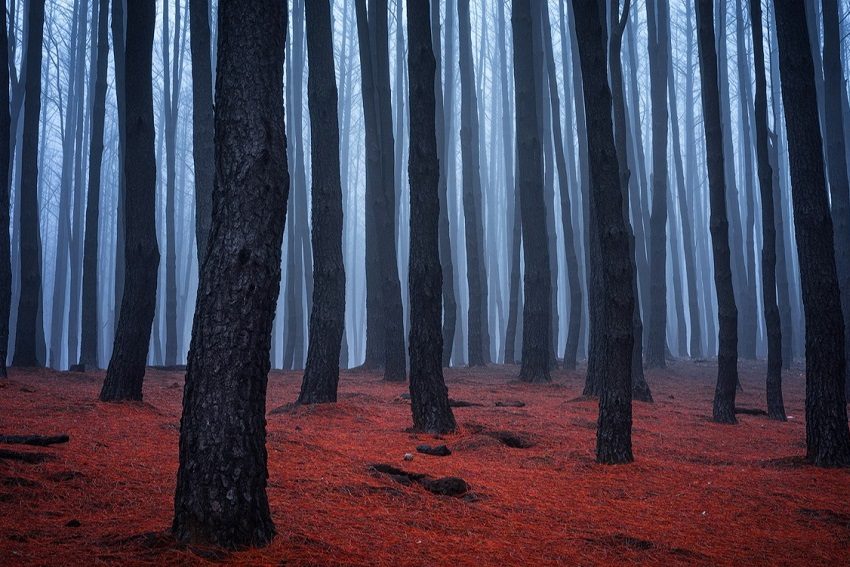Haunting visions of recovery in the Adelaide Hills

With his two striking photographs showing the aftermath and rebirth of a forest near Gumeracha after a bushfire, local photographer Ben Goode is a finalist in this year’s Australian Geographic Nature Photographer of the Year competition.
What is it about the Adelaide Hills, especially when in recovery, that draws you to them?
The Hills, especially in the cooler months, are just so atmospheric and fresh. My favourite environment to shoot in is fog and it is found everywhere in the Hills. Add to that stunning, lush foliage springing from previously charred scenes and it’s a place that always brings me so much peace and happiness.
How does it feel to document this area’s rebirth and recovery?
During 2015, I shot the northern hills extensively for the Rebirth series and pretty much every scene I shot brought up different emotions. From the vast burnt out area of the Mt Gawler Forest Reserve to haunting mist in a pine forest near Gumeracha, and my former favourite Adelaide Hills tree near Kersbrook burnt to a crisp. While each scene was haunting, I really tried to find the beauty and life among all the destruction. Some people had issues with me shooting a subject that brought them so much loss and fear but for me there is beauty in everything, and I really wanted to show that.
Broken Dreams and Left Behind are both incredibly haunting. You wrote that Broken Dreams was “rewarding but confronting”. Can you explain why?
Broken Dreams and Left Behind were taken during a shoot in a forest near Gumeracha. I had driven by it a number of times and was blown away by the stunning contrast of the reds and the black trees. I knew the scene needed heavy fog to fulfil my vision, however, and I waited a few weeks, checking the forecast each night. I finally got the condition forecast that I had been waiting for in early May 2015.
I woke up pre-dawn and drove to the forest to see a scene that was more hauntingly beautiful than any I could have imagined. Spending hours walking through that eerie and silent forest, I couldn’t stop thinking about how intense the area must have been for locals, firefighters and animals during the worst of the fire. The shoot has been my most successful in terms of print sales, competitions and critical acclaim but I just feel lucky to have experienced that moment in time.

You wrote that Left Behind shows “how fast and intense Australia’s bushfires can be”. What else did this shot and shoot reinforce to you about nature, especially nature that is close to civilisation?
The relationship between nature and nearby civilisation is always a tricky one. We want to live in beautiful places, surrounded by beautiful nature, but doing so will always take a toll on the natural world. We have to be aware to keep any harm to an absolute minimum. Having said that, fires have been a part of nature since before civilisation came along and nature is well prepared to take the worst of it and rebuild better than ever.
You were a finalist in 2016 with Hang in There. What is it about this competition that appeals to you?
I’m not one to enter many competitions but without a doubt this is my favourite. The quality of shortlisted entries is incredible and feature many photographers who I admire greatly. I love the emphasis that this competition puts on true nature photography as opposed to who can edit the best. Editing is an important part of photography but it’s refreshing to have this one competition really focus on the capture of amazing moments.

You shoot primarily in South Australia. Is this due to access or is there something about South Australia’s landscape that appeals?
There are a number of reasons why I shoot primarily in South Australia. When I started my photographic journey I shot all around the world but I soon realised that going to an amazing spot overseas that has been shot to death – and shooting it once before moving on to the next spot – just didn’t ignite my passion the way shooting local does. A big part of the enjoyment of photography, for me, is building relationships with the scenes I’m shooting. Coming back seven or eight times to shoot the same area and exploring the different ways light hits the subject in different conditions. It helps that South Australia has so many stunning, diverse landscapes, too.
Another reason is I now have two young boys and I don’t want to be missing out on precious time with them by travelling the world. A third reason is the simple fact that I do this for a living and while I have sold many prints of South Australian scenes, I have never sold even a single print of a scene taken outside of South Australia. It just doesn’t make sense personally, financially, or creatively for me to spend too much time and money shooting elsewhere.
2018 Australian Geographic Nature Photographer of the Year
South Australian Museum
Friday, August 24 to Sunday, November 11
naturephotographeroftheyear.com.au
earthart.net.au
The Adelaide Review is a media partner of the South Australian Museum